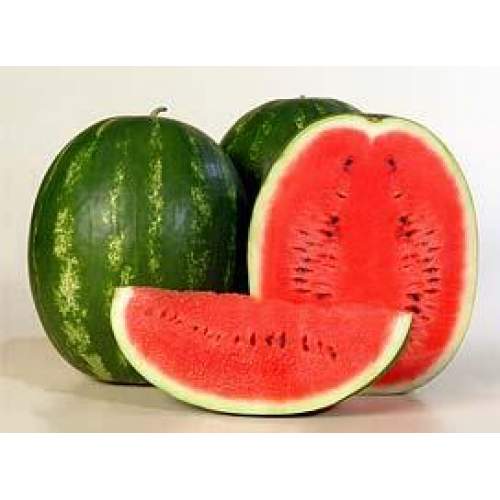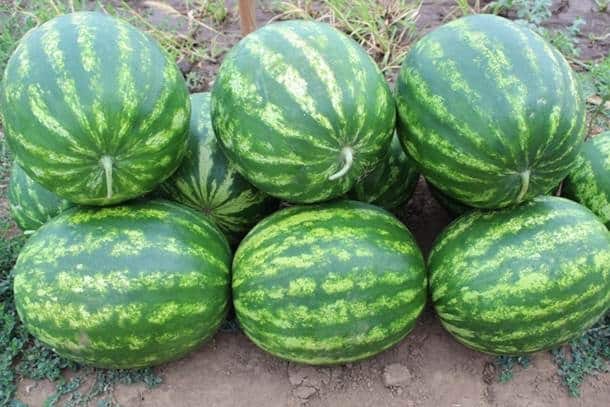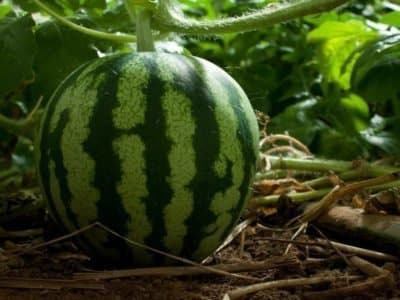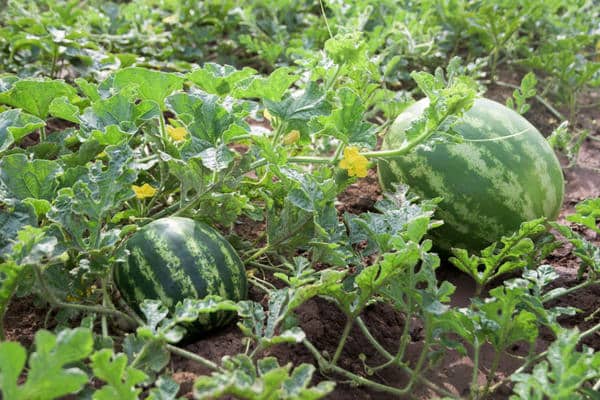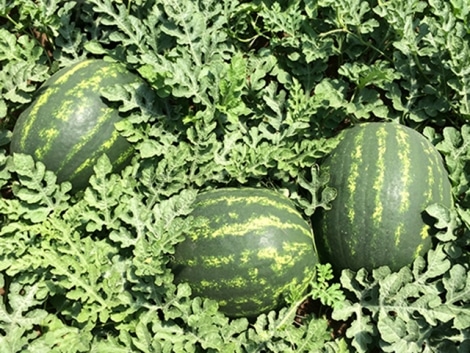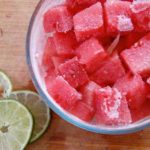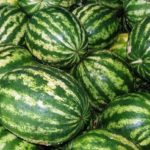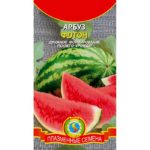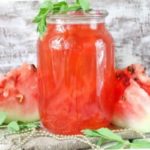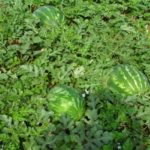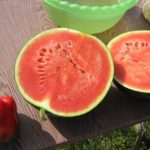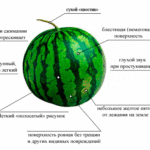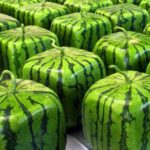Watermelon is one of the most favorite summer delicacies. Among the many varieties of the crop, the Karistan watermelon variety is distinguished by a whole range of positive characteristics, the main ones of which are good taste, high yield and small seeds.
Characteristics and differences of varieties Karistan and Karistan F1
Watermelon Karistan is a mid-early variety. The berries, after sprouts form, ripen on the 70th day. The fruit is round or oval in shape, weighing 10-12 kg.The smooth, medium-thick bark is dark green in color. The pulp is bright scarlet in color with small black seeds and is characterized by density and juiciness.
The variety description provides definitions of the pros and cons of watermelon. The main advantages of Karistan, thanks to which it deserves its place in the garden, include:
- high yields, both in greenhouses and in the open air;
- the presence of ideal taste and technological characteristics;
- ability to grow on any soil;
- intensive germination of planting seeds and smooth ripening of fruits;
- resistance to sunburn;
- long-term preservation without loss of taste, subject to proper storage;
- possibility of transportation over long distances, without loss of presentation.
The variety also has disadvantages:
- the likelihood of accumulation of small amounts of sugars during cloudy weather;
- lack of seedlings when planted in too cold soil.
Unlike the Karistan watermelon, the Karistan F1 hybrid ripens earlier and has a larger mass. The hybrid is more resistant to characteristic diseases and performs well on any soil. The energy and speed of growth of the plant is its main distinguishing feature.
History of selection and region of growth
The Karistan variety was bred at the very beginning of the 21st century by Dutch breeders working for the Syngenta company.
He became known in Russia in 2007, and began to enjoy enormous popularity already in 2012, when he was included in the State Register.
Thanks to its early ripeness and excellent transportability, Karistan watermelon is actively grown in all regions of Russia.This is an excellent choice not only for summer residents, but also for people selling watermelons, since the variety allows you to grow impressive and high-quality harvests of sweet summer berries.
Growing features and optimal conditions
Requirements for growing Karistan watermelon:
- a large amount of light and direct sunlight;
- optimal temperature;
- increased soil moisture;
- soil well fertilized with organic and inorganic substances.
To obtain a good harvest, it is necessary to adhere to all agrotechnical recommendations for cultivation, to create optimal conditions for active germination, flowering and ripening of fruits.
In the greenhouse
A warm room should be spacious, high, and made of durable material. It is best to use peppers, eggplants or cucumbers as neighbors. The soil needs to be nutritious, rich in minerals, but not too greasy. For fertilizer you need to use humus with nitrophos and superphosphate. You need to take care in advance of having a protective film in case of extreme cold.
Having prepared everything you need for growing, you can begin the process itself:
- Sow the seeds in individual cups or coconut pots with a diameter of 10 cm in mid or late April, after soaking them in warm water with the addition of a growth stimulant.
- Water regularly, cover with film and maintain a temperature of 25 C.
- Fertilize on the tenth day after sowing with complex mineral fertilizer.
- At the end of May, transplant the seedlings into well-warmed soil at a distance of 50 -70 cm and maintain the temperature in the greenhouse from 20 to 25 C, and the humidity not higher than 60%.
In the future, during the growing process, it is only necessary to maintain the optimal level of temperature and humidity in the greenhouse, prevent the formation of drafts and regularly water.
In the open ground
Watermelon of the Karistan variety, grown in open ground under the bright rays of the sun, will be much tastier and juicier than that grown in greenhouse conditions under film. First you need to choose a suitable area: it should be spacious and well lit. It is necessary to loosen and fertilize the soil. It is recommended to moisten the seeds in advance in warm water and place them in dug grooves 4-7 cm deep. The distance between planted seeds should not exceed a distance of 0.7 to 2 meters, and between rows - approximately 1.5 meters. It is necessary to carry out regular maintenance in the form of watering and weeding.
When growing Karistan watermelon in seedlings, you should:
- Place pre-soaked seeds in peat pots filled with moist soil and humus;
- Keep covered with film until sprouts appear, maintaining the temperature at least 20 C.
- After the first shoots appear, place in a cool room for 3-4 days.
- Water regularly, monitor humidity levels and temperature conditions, and, if necessary, apply nitrogen fertilizers in small quantities.
- When the weather stabilizes and becomes warm, transplant the seedlings into open ground, protecting them from the winds, watering and feeding them.
After transplanting the Karistan variety, you need to monitor the condition of the plant, check for various diseases and pests, regularly water, fertilize, and loosen the soil.
Diseases and pests, ways to combat them
The Karistan watermelon variety is not immune to diseases and pest invasions.Most of all, the culture is predisposed to fungal diseases. This situation especially worsens in cloudy times, in rainy weather, and when the temperature drops. The fungus attacks the foliage, root system and fruits of the plant. Diseases such as blackleg, powdery mildew, and olive spot are dangerous for the crop.
| DISEASES | |||
| Name | Description | Control measures | |
| Blackleg | Gray spots on leaves or stems that wither, rot and die over time | Eliminate the affected parts, weed well and treat the area with a solution of copper chloride (0.5%) | |
| Powdery mildew | The leaves become covered with a white coating and soon die. Fruits lose juiciness and sugar content | Remove affected foliage and branches, treat with caratan suspension (25%) 2-3 days before harvest | |
| Olive spot | The leaves become corrugated and covered with spots, and holes with an olive coating form on the petioles. The berries become deformed and stop growing | Treat with a suspension of cuprosan (80%), Bordeaux mixture (1%), benlate (80%), zineb (80%). Weed and remove affected parts of the plant | |
| PESTS | |||
| Name | Description | Control measures | |
| melon aphid | Insect colonies form on the lower leaves. Flowers and leaves fade and fall off | Sprinkle with infusion of ash, and in advanced cases - with Inta-Vir (8 g per 10 liters of water) The solution is designed for 10 square meters | |
| Spider mite | Cobwebs appear on the back of the leaves, which eventually become discolored and fall off. | Tear off and burn affected leaves or treat with chemicals | |
| Sprout fly larvae | They penetrate the stem, damaging the sprouts, and suck out all the juices | Spray with a special “fly” pesticide three times before flowering begins. | |
To get a lot of high-quality Karistan watermelon fruits, you should regularly inspect the plants and, if signs of a disease are detected, immediately determine the cause and urgently eliminate it.
How to determine the ripeness of a watermelon and harvest it
In order to harvest on time and not make a mistake, you should pay attention to the appearance of the fruit. The maturity of the fruit is determined by the dry stalk, yellow spots, and increased hardness of the skin.
You can also learn about watermelon ripeness by knocking, if the sound is dull, the watermelon is green, and a ringing sound indicates the beginning of the harvest. Fruits should be picked in warm, dry weather and stored in a dark, cold room with high humidity.

